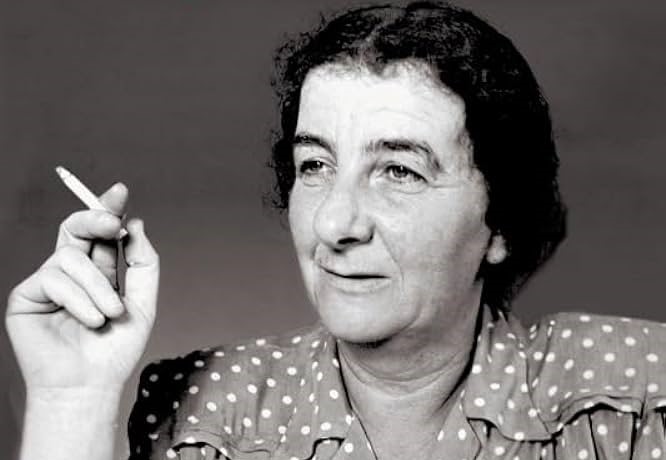The first female prime minister of her country and the third female prime minister of the world: Who is Golda Meir?
Golda Meir, who was held responsible for the heavy losses in the Yom Kippur War with Arab countries in 1973, could not withstand the pressure on her and resigned from her post as prime minister on April 10, 1974, and withdrew from the active political scene.

Golda Meir, the fourth Prime Minister of Israel, was born in May 1898 in Kyiv, then part of the Russian Empire, and immigrated to America with her family in 1906. Meir, who was included in a Zionist group during her high school years, became one of the most active members of the socialist Zionist movement Habonim Dror when she started teaching in the following years and organized actions in support of the first "kibbutz" that started to be established in Palestine, which was under the control of the British. In 1921, Golda and her husband Morris, who were deeply influenced by Zionist ideas, immigrated to Palestine. In 1948, after the establishment of the State of Israel, Meir was elected as a member of parliament and entered the Knesset. She served as the minister of labor for 7 years and the minister of foreign affairs between 1956 and 1966. On March 10, 1969, she took office as her country's first and the world's third female prime minister. Golda Meir, who was held responsible for the heavy losses in the Yom Kippur War with Arab countries in 1973, could not withstand the pressure on her and resigned from her post as prime minister on April 10, 1974, and withdrew from the active political scene. Golda Meir, who wrote an autobiography called "My Life" during her retirement days, died in Jerusalem on December 8, 1978.
Golda Meir (3 May 1898 – 8 December 1978) was an Israeli politician who served as the fourth prime minister of Israel from 1969 to 1974. She was Israel's first and only female head of government, the first female head of government in the Middle East, and the fourth elected female head of government or state in the world.
Golda Meir was born Goldie Mabovitz, the daughter of Moshe and Bluma Mabovitz, in May 1898 in Kyiv, then part of the Russian Empire. Golda, who spent her childhood in Kyiv, immigrated to America with her family in 1906.
While she was attending high school in the North Division, she joined a Zionist group. Despite her family's pressure to drop out of school and get married, Golda continued her education at the University of Wisconsin-Milwaukee received a teaching license, and married Morris Meyerson at the same time. When she started teaching, her paths crossed with the socialist Zionist movement Habonim Dror. She became one of the most active members of this organization during the First World War and organized actions in support of the first "kibbutz" that began to be established in Palestine, which was under the control of the British.
By 1921, Golda and Morris, who were deeply influenced by Zionist ideas, immigrated to Palestine. Golda continued to work actively here and soon contributed to the formation of the infrastructure of the political organization among immigrant Jews who came to Tel Aviv. She became a well-known face, especially with the duties she took for the political movement known as the "Women's Council".
In 1932, she went to the USA again and started to serve as the representative of the "future" state of Israel. Two years later she returned to Palestine again, this time working for the Israeli Labor Union. While she was trying to create an infrastructure for the political institutions of Israel that were aimed to be established, she was also involved in activities that would improve the dialogue with the United Kingdom, which controls Palestine, and the United States, another important actor of the region. When the State of Israel was established in 1948, one of the signatures on the Declaration of Independence belonged to Golda.
In the same year, she went to Moscow to work at the embassy of her newly established country. After playing an active role in establishing good relations with the Soviets, she headed to the USA again upon the instructions of Prime Minister Ben Gurion. Here, she met with Zionist groups and worked to obtain the necessary budget for military expenditures through donations and collected approximately 50 million dollars. After returning to her country, she was elected as a member of parliament and entered the Knesset, and soon she was appointed as the minister of labor.
After serving for 7 years in the Ministry of Labor, where she came in 1949, she was appointed as the Minister of Foreign Affairs. Meir, who served as Minister of Foreign Affairs between 1956 and 1966, resigned at the end of the decade due to health problems, but it did not take long for her to return to active politics and she was appointed Secretary General of Mapai in 1967. Meir, who restructured her party within two years and merged with the Israeli Labor Party and two other parties, had to postpone her retirement for the second time with the death of then Prime Minister Levi Eshkol in February 1969.
On March 10, 1969, she took office as her country's first and the world's third female prime minister. Golda Meir, who was held responsible for the heavy losses in the Yom Kippur War with Arab countries in 1973, could not withstand the pressure on her and resigned from her post as prime minister on April 10, 1974, and withdrew from the active political scene.
Golda Meir, who wrote an autobiography called "My Life" during her retirement days, died in Jerusalem on December 8, 1978, and was buried on Herzl Hill, also in Jerusalem.
